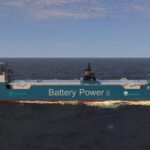Energy News Beat
Whatever one thinks about its causes, course, and consequences, the war in Ukraine rages on. That unavoidable fact has brought many in Europe to something of an epiphany. In late February, at a summit of European leaders in Paris, French president Emmanuel Macron asserted that “[t]his is a European war,” and asked his fellow leaders, “Should we delegate our future to the American electorate? The answer is no, whatever their vote.”
There’s a lot to unpack in this declaration, but it was surely on the minds of those gathered that, if Macron’s assertion is to have any weight, then, as British commentator Daniel Johnson put it, what “really needs to happen . . . is for German industry to switch from making cars to armaments—from butter to guns—before it is too late. If America is starving Ukraine of ammunition, Europe must step up.”
But could it?
War concentrates the mind. But the jury is out on whether European leaders are really connecting all the dots. Set aside the issue of money (and that’s a lot to set aside, given the scale of military investments); the bigger challenge is that Germany is in the process of self-deindustrialization, along with much of the rest of Europe.
Germany’s long-standing anti-hydrocarbon energy policies have created higher-cost energy, triggering the diminution and even exit of major industries. That’s because building machinery is not only energy-intensive but also particularly dependent on hydrocarbons. Consider that, compared with two decades ago, Germany’s overall industrial energy costs are up some 200 percent. German industrial-electricity costs, in particular, despite policies to insulate industries (not consumers), have been rising and now run nearly 300 percent higher than two decades ago—and that’s after coming down from the recent, crippling price spike caused by the realignment of energy flows after the invasion of Ukraine.
The effects of Europe’s price-hiking energy policies are clear in one fact: the output—in tons, not dollars—of that continent’s petrochemical industry has been steadily declining over the past two decades and has now collapsed to a half-century low. That may excite the ban-plastic-straws crowd, but in the real world, it takes hundreds of megatons a year of petrochemicals to produce nearly everything that civilization needs, from energy-saving insulation to windmill blades to all manner of medical and military products. If Europe’s current energy path is not reversed, it’s no exaggeration to say that Germany won’t be making cars or tanks.
The illusion that nations can casually tinker with or ignore the “old” energy-intensive industries in favor of modern services arises from a failure to recognize that all services are built on manufactured products and industrial supply chains. The costs of the latter are ignored when energy is cheap. And the illusion that there are easy, cost-effective energy alternatives to, say, using coal to make steel, natural gas to produce fertilizer and high-performance ceramics (used everywhere, including for armor), or oil for powering vehicles (including military ones) arises from naïve proposals that call for reshaping entire industries overnight through mandates and taxes.
Like the proverbial frog in the slowly boiling pot, the cumulative damage done by misguided energy/industrial policies takes time to become obvious. It’s obvious now. Two decades of anti-hydrocarbon green energy pursuits have raised Europe’s energy costs. Not so in China, Russia, or the United States (yet).
Of course, everyone knows the motivation for Germany’s energy policies: to reduce carbon dioxide emissions. And German emissions have declined by about 20 percent compared with two decades ago. But it also bears noting that the increased emissions from China over just one year wiped out all the (expensive) German reductions.
Creating an era of high-cost energy is a double-edged sword. It not only leads to the loss of both existing and new industrial production but also robs the economy of capital that could be used elsewhere, not least for military preparedness.
Over the past two decades, Germany has squandered something like $2 trillion, likely more, to achieve an “energy transition” that will accomplish nothing significant. That $2 trillion total comes from two costs. First there’s the nearly $1 trillion spent on subsidizing wind and solar machines built with the goal of nearly doubling the size of that nation’s electric grid, even though total electricity production grew by less than 10 percent. The effect was nearly to triple Germany’s electricity costs, which, in turn, drained another $1 trillion from the Germany economy over this period.
In economic terms, spending a lot more to get only a little more output is the inverse of productivity. Depressing productivity not only enervates economies (by contrast, U.S. GDP over that period grew three times as fast as Germany’s), it also reallocates precious capital away from more productive or more important purposes.
It’s ironic, and indeed perhaps tragic, that the squandered $2 trillion roughly equals Germany’s cumulative two-decade underinvestment in its NATO commitment. Adding to that irony, as Germany’s finance minister observed last year, the German malinvestment in energy domains was made possible in large measure by imports of cheap Russian natural gas.
Meantime, exports of oil and natural gas continue to be the primary sources of revenue for the Russian economy and war machine. The West’s imposition of sanctions on purchasing Russian fuel did little to change the equation. Instead, Russian sales shifted to Asia. And because of sanctions, those fuels have been purchased at a discount, thereby giving China and other buyers an economic benefit for their industries.
Energy and wars are inextricably linked. Wars have been fought over energy, and warfighting consumes energy. The Ukraine conflict is consuming oil at a furious rate, leading to carbon dioxide emissions wiping out over half of Germany’s reduced emissions. And low-cost energy is essential for fueling the industries that build war machines.
As Germany has learned, decisions its leaders made years ago have consequences today. Meantime, U.S. decisions made years ago are what led to a massive export infrastructure for liquified natural gas (LNG)—a capability that was the major reason Germany could replace most Russian gas quickly. (The Biden administration’s “pause” on LNG exports has sent a chill into the necessarily long-term planning for that industry.) Meanwhile, Qatar, the world’s second-biggest LNG supplier, has announced a major acceleration in its plans to expand export capabilities. Given the history of the Middle East, one might reasonably ask, “What could possibly go wrong?”
In Carl von Clausewitz’s On War, we find one of many truths: when it comes to war, the “best strategy is always to be very strong.” The essential first-order feature of that aphorism is economic strength, which is what enables nations to build and field strong militaries. It is impossible to have a strong economy without massive, reliable supplies of cheap energy. In Germany, England, and much of Europe, we’ve seen the inverse of this: expensive policies pushing an “energy transition” to become hydrocarbon-free. Sadly, the only transition Europe has seen is one in which it has moved from strength to weakness. One can only hope the United States does not follow this path.
Take the Survey at https://survey.energynewsbeat.com/
ENB Top News
ENB
Energy Dashboard
ENB Podcast
ENB Substack
The post The Energy to Prevent and Prosecute Wars appeared first on Energy News Beat.








